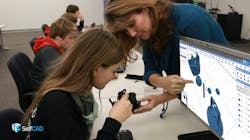3D design and printing technology has advanced at an alarming rate. We can now print complex objects from different materials, in different colors, in rapid time — even in the comfort of our own homes.
Then there’s the varied commercial applications for 3D printing (3DP). One survey of US manufacturers found that two out of three companies are already adopting 3DP in some way. Some of these companies include General Electric, Nike, Airbus, Amazon, Hasbro, Hershey’s, Boeing, and Ford. And we hear countless stories of 3D-printed houses, cars, aircraft components, musical instruments, shoes, robots, and body parts, just to give a few examples.
Given these developments, the question arises: What lies ahead for 3D printing?
As 3D printing becomes a common tool to the next generation, we will see more design that use 3D printing to optimize products.
3D Printing: An Alternative (or Accessory) to Conventional Mass Production
Barack Obama is quoted as saying that 3D printing “has the potential to revolutionize the way we make almost anything.” That is certainly true. And a lot has changed in the five years or so since those words were uttered. In fact, improvements in 3D print efficiency, and the reduction of associated costs, means that 3D printing is now a powerful competitor to conventional mass production.
As an article published by Forbes highlights: “3D printing is an unstoppable force. Not too long ago, the printing speed and limited output of 3D printers made them suitable only for rapid prototyping. But in the coming years, 3D printers will be at the heart of full-scale production capabilities in several industries… Manufacturing as we know it will never be the same.”
Consider an example. According to an article by The Economist, the sporting goods manufacturer Adidas intends to make 3D-printed soles for its shoes at two new, highly automated factories, so it can bring their shoes to market faster and keep up with fashion trends. This is a significant improvement because, as the article relates, “getting a design to the shops can take months. The new factories, each of which is intended to turn out up to 500,000 pairs of trainers a year, should cut that to a week or less.”
As this example shows, the limitations normally associated with commercial 3D printing, namely, high production costs and slow turnover, are being eliminated as technology improves.
Of course, whether 3D printing meets a company’s manufacturing needs depends on the specific design and application. Nevertheless, all indications are that the use of 3D printing will continue to grow. The materials used are getting more diverse, costs are going down, and new approaches to 3D printing are leading to further improvements.
SelfCAD is cloud-based CAD software that works towards wide adoption of user-friendly drafting.
3D CAD an Integral Part of Manufacturing
Whether it be using traditional or state-of-the-art technologies, 3D CAD is at the heart of the manufacturing industry. Why? Because the 3D design process and prototype testing occur well before full-scale production takes place. So, having the 3D CAD skill set is certainly an asset.
Some CAD companies are creating user friendly, easy-to-learn, cloud-based, all-in-one 3D design and printing software packages for students and home learners. As 3D printing will continue to grow, acquiring 3D CAD skills with these easy-to-access, free or affordable CAD packages is a worthwhile venture.
Tyler Berrigan is a professional writer specializing in 3D printing, STEM, and education.



